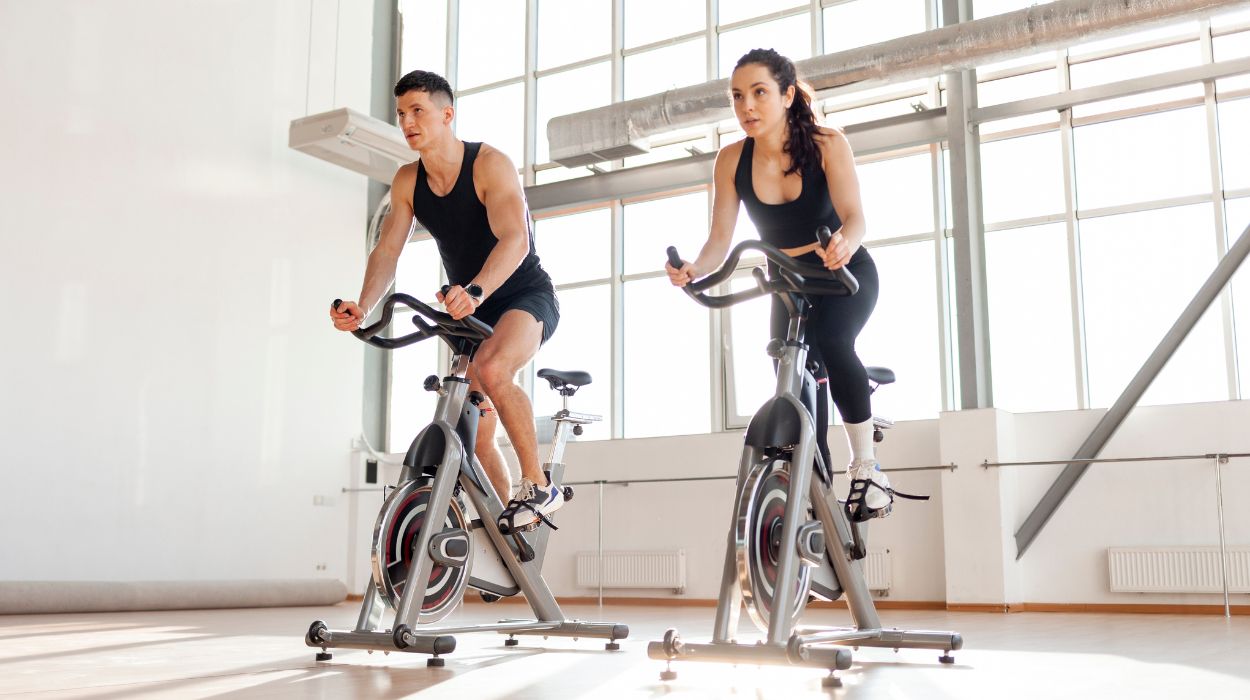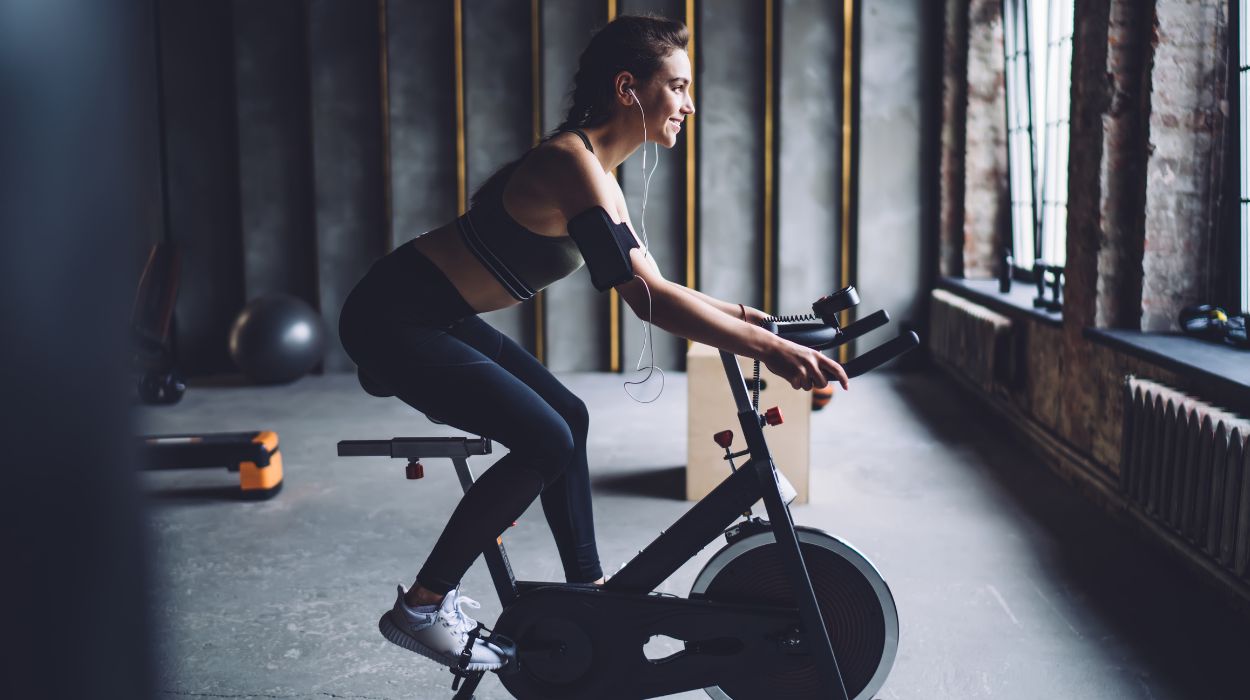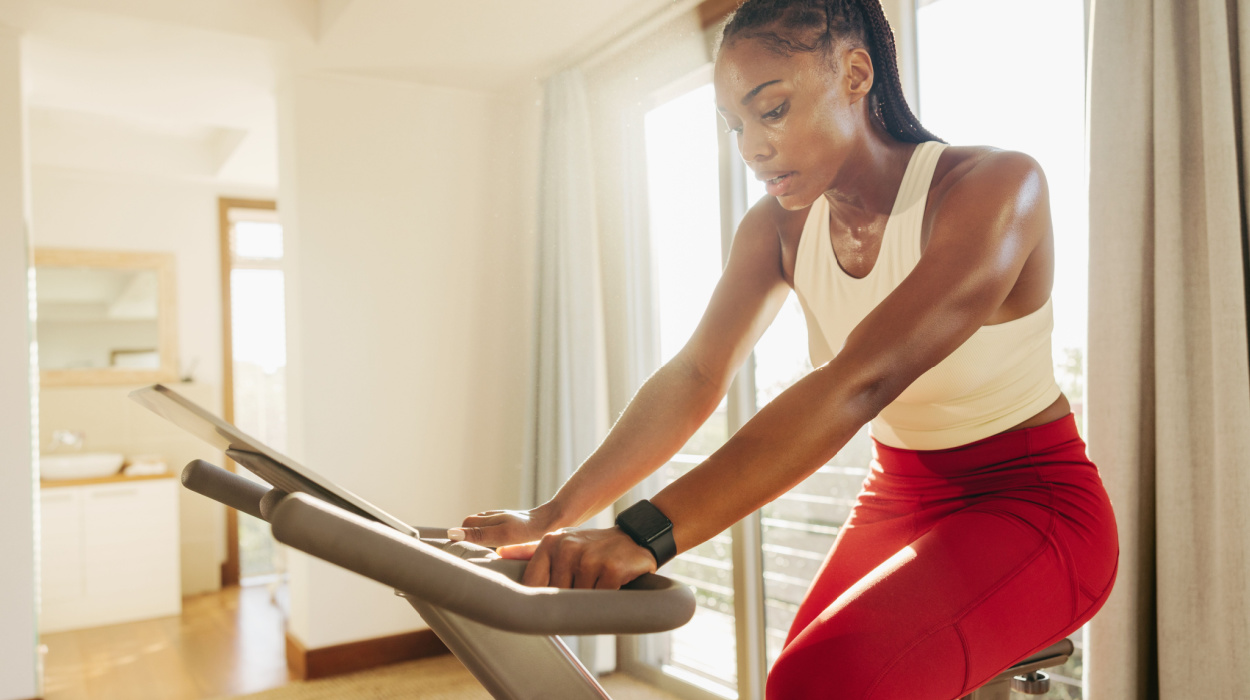Curious about how you begin losing belly fat once and for all? Dive into the secrets of shedding those extra inches by discovering how long you should ride a stationary bike to achieve your goal.
In this article, we will look at the incredible advantages of hopping on a stationary bike and how many calories you can burn on exercise bikes. Exercising and leading an active lifestyle is sure to set you on the right track to achieving your weight loss goals.
How Long Should People Ride A Stationary Bike To Lose Belly Fat?
People should consider riding a stationary bike for a minimum of 150 minutes a week to see a reduction in belly fat. Consider following a healthy diet and creating a calorie deficit so you can expect to see results faster.
How Long Should You Ride A Stationary Bike For Belly Fat Loss?

Here are some aspects to consider when deciding if you want to start using a stationary bike as part of your exercise routine and how long you should ride a stationary bike.
Workout Length
Riding a stationary bike offers a cardio aerobic workout with minimal impact, making it an excellent choice for achieving your weight loss goals. According to the World Health Organization,[1] you should aim to do: 150 minutes of moderate-intensity exercise per week or 75 minutes of high-intensity exercise per week.
So, to see the benefits of riding a stationary bike on your stomach, aim to cycle for at least 150 minutes a week.
You can exercise two to three times a week, splitting sessions into 30 minutes to an hour- whatever works best for you. This will make you feel more relaxed, keep you on track with your goals, and help you lose belly fat.
Frequency And Intensity
Tailor your fitness regime to fit into your life — whether it’s embracing short, daily workouts or going for longer sprints spread out across the week. Find a rhythm that resonates with you, something you feel you can keep consistent for the long run. CDC recommends[2] 150 minutes a day of moderate-intensity physical activity to remain healthy and keep weight at bay.
Moderate intensity is determined to be 64%-76% of age-adjusted heart rate[3] (220-age=maximum heart rate x intensity).
If cycling is your thing, a stationary bike is an ideal choice to add to your workout routine. By dedicating 20 to 40 minutes a day at a moderate intensity to this enjoyable activity, you can lose weight on an exercise bike — you will be making huge advances toward your weight loss goals.
Diet Combined With Exercise
Make sure to combine your workouts with a healthy balanced diet and good sleeping habits. Your well-being is defined by healthy routines that keep you feeling energized, happy, and focused, along with getting the right amount of rest. Creating a calorie deficit[4] will also help you to burn fat faster. You can lose weight on a stationary bike by burning calories, and you will achieve this faster if you also consume fewer calories.
HIIT And Interval Training
Studies have shown that interval and HIIT training on a stationary bike[5] help you burn fat, which will help you lose belly fat too. You can change the speed and resistance on a stationary bike, making it easy to adapt and switch between high and low-intensity peddling during your workouts.
Ten minutes of HIIT training a day riding a stationary bike can massively help you to lose weight.
Low-Impact Home Workout
A stationary bike is a low-impact option for those concerned about existing injuries or causing new ones. If you prefer to exercise in the privacy of your own home and you have the space for a bike, it’s an excellent and convenient choice for helping you to shed some extra pounds.
Does A Stationary Bike Burn Belly Fat?
Riding a stationary bike can certainly help you burn belly fat. It’s a fantastic form of aerobic exercise[6] — good for keeping your cholesterol levels down and your heart happy. For those looking for something low-impact, you can expect to achieve many things by incorporating some cycling into your days.
- Fat Loss and Calories: Regular stationary biking can help you lose fat throughout your body including visceral fat in the belly, although it’s hard to specifically target only one area. Being a cardiovascular workout, you will be burning calories as you peddle, helping you to lower your overall body fat.
- Increased Metabolism: Increasing your metabolism[7] will help you to burn fat long after you finish your workout on the exercise bike. Cycling also helps you build muscle, and the more muscle you have, the more fat you burn.
- Engage Your Core: While you are pedaling, you will activate your core muscles which will help to tone your belly and improve the shape of your waistline. Having a strong core is essential for good posture and protecting yourself from injuries.
Adults want to aim for a BMI of 18.25-24.9[8] for a healthy weight. Abdominal fat can be tricky to get rid of — but a bit of fat is harmless; subcutaneous fat, the visible kind is usually okay in small amounts. Visceral fat — the kind surrounding your organs, if you have too much of it, can be an issue and increase your chances of heart disease.
How Many Calories Does A Stationary Bike Burn?
Curious about how many calories you can burn on a stationary bike? It depends on different factors, such as body weight, muscle mass, and diet.
According to the CDC,[9] riding exercise bikes burns 3.5-7 calories a minute or 105-210 calories in half an hour.
So, if you are looking for ways to burn belly fat effectively without using a fat burner, you will see consistent results in your fitness routine. It takes a calorie deficit of 500-1,000[10] calories a day through burning calories and restricting caloric intake to lose 1-2 pounds per week.
How To Ride A Stationary Bike Effectively

Ready to start your stationary bike sessions? Check out these tips on how to ride effectively:
- Customize Your Setup: Get comfortable by adjusting the bike to suit your body and fine-tune the resistance for your desired speed.
- Correct Grip: Grip the handlebars with intention and keep control and stability while cycling.
- Good Posture: Keep your back straight. Ensure good posture to engage your core muscles and prevent straining your back. Adjust your seat to ensure correct alignment.
- Pedal Smoothly: Focus on having a consistent pedal stroke for efficiency and engaging your muscles. Assure the correct foot pedal distance for optimum pedaling by correctly adjusting seat height.
- Hydration is Key: Staying hydrated is crucial for any energized workout. Keep some water nearby.
- Warm-up and Cool-down: Prep your muscles with a gentle warm-up and finish with a cool-down to help with your recovery.
- Stretch it Out: Remember to stretch after your workouts to avoid feeling stiff.
Reasons People Should Consider Indoor Cycling
You might be wondering why you should consider indoor cycling over other forms of exercise. While cycling is great, you’ll want to combine it with some strength training to achieve your goals. Here are some reasons to add it to your exercise regime.
Low Impact Cardio
- Low-Impact Workout: If you have existing injuries, indoor cycling can be an ideal choice. Those who have issues with their knees from running or back injuries from high-impact sports will find that it’s a gentle exercise that can help avoid future injuries.
- Cardio Fitness: Cycling will improve your cardiovascular health by increasing your heart rate, which in turn may help you to lose weight. Cardio workouts help you burn visceral abdominal fat — the fat around your organs that can become dangerous if you have too much. It will also help you to build lean muscle while losing belly fat.
Lose Weight and Get Toned
- Weight Loss: Expect to burn calories riding a bike; aerobic exercise is known to play a key role in weight management. You may also consider adding a supplement to a healthy diet and lifestyle. Supplements are meant to fill in nutrient gaps in your diet.
- Muscle Tone: By cycling, you will build leg muscle and engage your core. This will help you to have a more toned stomach, and your legs will become stronger.
Improve Mood and Balance Safely
- Safe: Unlike outdoor cycling,[11] you are unlikely to suffer from falls or run the risk of being hit by a car cycling along the road, making it a very safe option.
- Balance: You will be practicing your coordination skills when cycling, which may contribute to better balance in the long run.
- Improved Mood: Regular exercise is key to good mental health.[12] By incorporating some cycling into your schedule, you will see improvements in your mood; you can even include a diet pill as an extra boost. If you work from home, consider fitting some pedaling in to break up your day, which will give you an extra buzz while also helping to keep you focused and motivated.
Conclusion
To sum up, indoor cycling has many benefits;[13] aim for at least 150 minutes of moderate-intensity indoor cycling per week for effective belly fat loss. Consider adding high-intensity training[14] to your routine for an added calorie burn and possible belly fat reduction. Spot reduction is tricky, so be sure to combine cycling with a healthy diet and a variety of exercises to see the best results.
Frequently Asked Questions
So, how long should you ride a stationary bike to lose belly fat? It depends on the intensity of your workouts, diet, and lifestyle. Consistency is key — aim for[15] 150 minutes of moderate exercise or 75 minutes of intense exercise per week.
Aim for a moderate speed that raises your heart rate. Consider interval training, mixing intense bursts with lower bursts of activity. Consistency is key.
An increase in your stamina, endurance, and muscle tone may be noted. Regular cycling will improve your mood and sleep quality and reduce stress. If your workouts are intense and you follow a strict diet with enough of a calorie deficit, you will start to lose weight.
It depends on your body weight, your diet, and how much you exercise. You will need to create a calorie deficit and cycle every day to achieve your goal.
Choose the one you enjoy most; the more consistent you are, the more results you will see. Walking is low-intensity but still great exercise. Both cycling and walking will engage your core and improve posture, tone, and silhouette.
It depends on your fitness level and weight. Expect to see results after 150 minutes of cycling a week and modifying your diet according to your goals.
About 20-40 minutes a day of moderate-intensity or 10-20 minutes of high-intensity cycling. Along with a balanced diet and healthy lifestyle, you will see improvements in your weight loss goals.
 Evidence Based
Evidence Based
